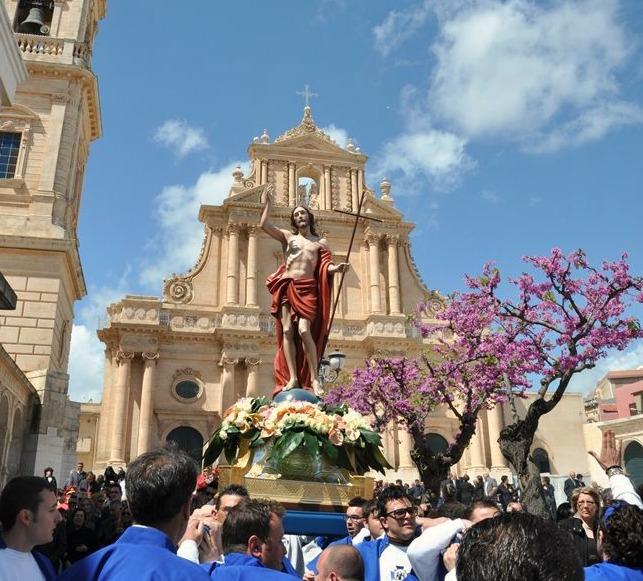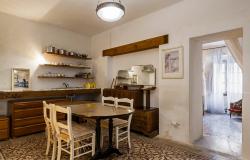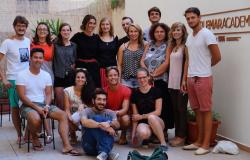The Holy Week traditions in Sicily are an incredible combination of religious festivals with archaic celebrations of the rebirth of nature, of spring over winter, of life over death.
They are mostly the legacy of the 17th century Spanish domination of the island, and still bear a close resemblance to current Easter traditions in southern Spain. A moltitude of ancient rituals take place in various towns and villages around the island. Solemn processions and reenactments of the passion of Christ, culminate in the joyful celebrations of Easter Sunday with fireworks, doves, flowers and cheerful music accompaning the statue of the risen Christ meeting with that of the Madonna for the so called "'ncuontru" (encounter - the moment they meet).
 Picture by Giuseppe Arangio courtesy of Enna's Proloco
Picture by Giuseppe Arangio courtesy of Enna's Proloco
After the procession, people wish each other “Buona Pasqua” (Happy Easter) and go back home to share a traditional meal with the rest of the family.
Both devotees and tourists can attend the events organized by the "confraternite" (the brotherhoods) to reenact the last days of Jesus' life until the resurrection on Easter Sunday. Below we look at three different destinations famous for the Holy Week traditions: Trapani, Enna and Ispica.
I Misteri di Trapani
The Procession of the Mysteries in Trapani, represents the most important traditional event of the year for the local community, attracting thousands of visitors, and is one of the oldest continuously running religious events in Europe, having taken place every Good Friday at least since the Easter of 1612.
In Trapani, these traditions can be traced directly back to Spain. During the XVII century, the brotherhood 'Confraternita del Preziosissimo Sangue di Cristo', that existed in Spain since the XV century and was founded in Trapani in 1602, commissioned local artists to create statues representing various moments of the passion of Christ.

Picture courtesy of Trapani's Unione Maestranze
The brotherhood, that was later merged with the preexisting 'Confraternita di San Michele', is now known as the Confraternita di San Michele Arcangelo.
Over the years, the costs and difficulties of taking care of the statues and the organisation of the procession called for the involvement of the local Maestranze (working categories such as grocers, fishermen, bakers, butchers, etc.) that took on an increasingly prominent role over the years.
The Maestranze organised the Holy Friday procession and each one of them was in charge of a specific sculpture of the Misteri. Even today, each maestranza is identified with a Mistero and often the statue is called with the name of the maestranza itself. For example, the statue representing the Deposition is taken care of by the Tailors.
Currently, there are about twenty Maestranze involved. On the first Friday of the Lenten period they do the "Scinnuta" (a Sicilian word indicating that they take something down) of the statues, exposing the statues to the public so that people can admire them. There is strong competition among them, so details regarding the procession, such as the final decoration of the statue on Holy Friday, are kept secret until the very last minute.
The actual procession lasts 24 hours and is accompanied by local marching bands. The statues are taken around Trapani by the 'portatori', volunteers who carry them on their shoulders and walk with a particular step called 'nnacata', rocking sideways. You can see this movement quite clearly in the video below.
La Settimana Santa a Enna
The religious traditions of the Holy Week in Enna go back to the sixteenth and seventeenth century and are also connected with the Spanish domination of the island. They begin on Palm Sunday with "l' Ura" (the hour), when the members of the current fifteen confraternities depart from their respective churches accompanied by marching bands playing sad funeral tunes to reach the main Cathedral for an hour of Eucharistic adoration.
 Picture by Giuseppe Arangio courtesy of Enna's Proloco
Picture by Giuseppe Arangio courtesy of Enna's Proloco
On Good Friday, thousands of hooded members of the confraternities march in complete silence back to the cathedral through nearly all the streets of Enna. First they stop in the Chiesa dell'Addolorata to take the statue of Our Lady of the Seven Sorrows, then they reach the Cathedral to take the Urn of the Dead Christ. Finally, the solemn procession begins, led by the brothers wearing capes of different colours.
At the rear of the procession, beneath a canopy, is a cross containing a reliquary of the crown of thorns followed by the Urn of the Dead Christ and the statue of Our Lady Of Sorrows which are carried as far as the cemetery and then back to the Cathedral by the 'portatori' on their shoulders.
On Easter Sunday the Risen Christ and Our Lady are reunited in the Cathedral square for "'a Paci" (literally The Peace),
Finally, on the 'Dominica in Albis', the Sunday following Easter, the confraternity of the Holy Saviour goes to the nearby Lombard castle for a special blessing of the fields surrounding Enna.
La Settimana Santa a Ispica
Ispica is a small town in the South Eastern part of Sicily, renowned for its Easter traditions, especially its Maundy Thursday and Good Friday processions which see the locals divided into two opposing factions, 'cavari' (referring to the confraternity of Santa Maria) versus 'nunziatari' (referring to the confraternity of the church of the Annunciation), with a rivalry which can only be compared to that of Siena's 'contrade' during the famous Palio.
 Picture by Claudio Moncada courtesy of Confraternita della SS Annunziata
Picture by Claudio Moncada courtesy of Confraternita della SS Annunziata
The festivities start on the Friday before Palm Sunday with the 'Santa Cascia', the deposition of Christ outside the Annunziata church and the live reenactment of Jesus entrance into Jerusalem on Palm Sunday.
On Wednesday night of the Holy Week people gather at three in the morning in the archeological area of Cava d'Ispica for the reenactment of the passion of Christ which end in the church of Santa Maria Maggiore.
The following day, on Maundy Thursday, they go back to the same church for the 'scinnuta'. The priest knocks three times on a decorated panel that covers 'U Patri a Culonna", the statue of Christ tied at the column. The panel opens up and the statue is brought to the centre of the church while the marching band plays a special march composed by a local musician, maestro Belisario, for this specific ritual.
The procession takes place in the afternoon, with the Confrati of Santa Maria Maggiore wearing their red mantled vest and the statue carried by the 'portatori' through nearly all the streets of Ispica, shouting 'culonna culonna' (column).
Similar rituals take place on Good Friday in the Church of the annunciation for "U Patri a Cruci", Christ carrying the cross, with the marching band playing another march composed by maestro Belisario. In the afternoon the procession is lead by men dressed like ancient Roman legionaries riding on horses, the Confrati of the Annunziata church wear their blue mantled vest and the sculpture of Christ is carried by the 'portatori' shouting 'cruci cruci' (cross).
Both processions include a solemn moment when the statue of Christ meets with the statue of Our Lady of Sorrows.
While the two confraternities are rivals and the local population can roughly be devided into "cavari", devoted to "U Patri a Culonna" and "nunziatari", devoted to "U Patri a Cruci", on Easter Sunday the whole town is reunited for the procession of the "Risuscitatu", Christ Resurrected meeting the Virgin Mary.
Witnessing one of this ancient rituals is a unique experience and something that on its own makes a trip to Sicily during Easter worthwhile. If you are not in the area of Trapani, Enna or Ispica, you will surely find a town in the area you are visiting with similar traditions. In the meantime we hope the videos included will give you a hint of what the actual events are like.








